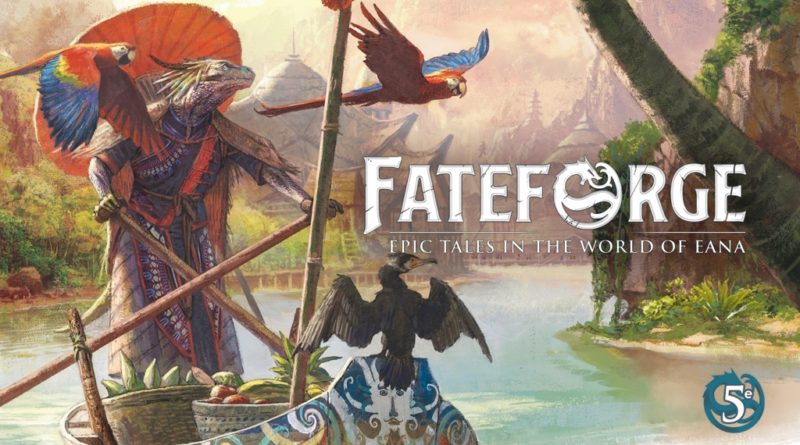RPG Review: Fateforge
History shows us what the Fate-chosen are capable of. They can build empires, craft fearsome artifacts, and alter the course of history for better or for worse. Initially in the service of divinities and working toward their purposes, these heroes may hope to free themselves from their sway thanks to the power of the Fateforge.
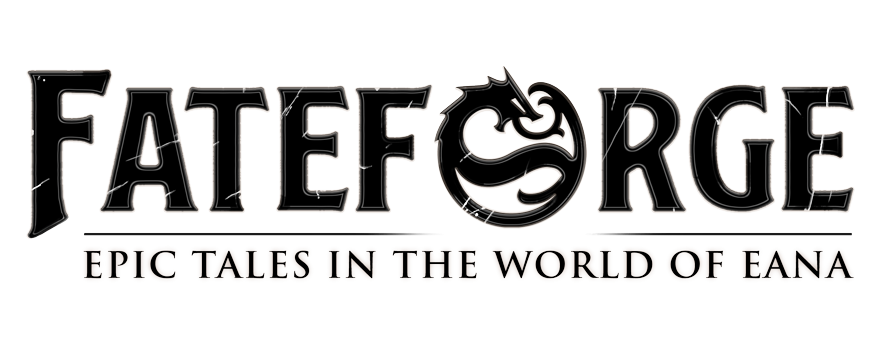
Fateforge is a standalone setting supplement for 5th Edition Dungeons & Dragons, meaning you can play Fateforge without using the 5th Edition books at all. It is on Kickstarter at the time of publication. The full rules including character creation is handled in the Adventures book, while all magic is covered in the Grimoire. Magic is handled separately due to the unique nature of it within the setting.
Characters are the Fate-Chosen, special people who have unlimited potential, which easily works around the question of “why is my character special?” They’re special because they are Fate-Chosen.
The Fate-chosen, designated by the gods, stand out from ordinary people, coming into their own as they go through ordeals and expose themselves to danger. They are capable of mastering a repertoire of techniques and spells much larger than what any other denizen of Eana may dream of. They may perish before they get to change the destiny of nations—if not of entire worlds—but whatever path they follow, they hold within themselves exceptional potential.
Your character can be Awakened, Close to Awakening, or Dormant. This is up to the player, and can have a big effect on the game. Dormant characters haven’t tapped into their magical potential. You can still play a class that uses magic, and gain the ability to learn spells, but are unable to use any benefits of magic. This works well for a campaign that is heavy on roleplay. Why not play a Wizard who has studied and studied, but just CAN’T quite cast spells? Or a Cleric who prays to their god, but has yet to hear from them. I like the concept of a Warlock who is seeking knowledge of some forgotten entity, but has yet to draw its attention. Close to Awakened means the character’s spark of magic is beginning to rumble, but perhaps won’t emerge for a few sessions. And Awakened characters have full access to magic.
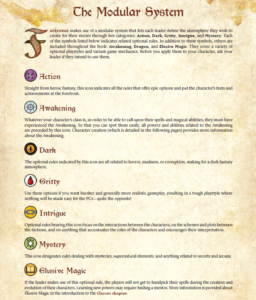
The book has a series of icons in it, which feature variant rules helping DMs choose how they want to focus the themes of the campaign. The blood drop icon allows you to make the game grittier and bloodier. The dragon eye is aimed at making the game darker, more full of horror. Tied knots represent intrigue. It’s a cool idea that makes it easier to choose your variant rules. Simply tell your players that the campaign will be a Dark and Gritty campaign, and they know they can use any rules with those icons. This is something we were promised a bit of in the playtest for D&D 5e, something a bit more modular, but we didn’t get it to the extend we’re getting here, which makes me very happy.
The world is incredibly fleshed out, providing a complete setting including a cosmology, gods, dozens of kingdoms and a whole host of other information. There are even multiple criminal guilds all seeking to one-up one another.
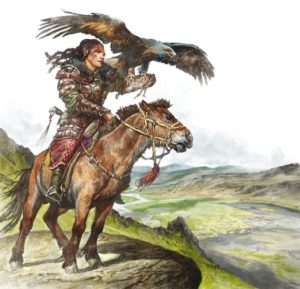 For races, all races in the PHB are available, and all have slight variations on the standard races, but particular note should be made of the Dragonborn, Tieflings and Half-Orcs (called Merosi in this culture, as Half-Orc is considered offensive) get their own specialized entries in the Player’s Guide, since these two races have distinct flavor differences from the standard races of D&D. The Tieflings have a lot of information on them, looking into how they came to exist. Just like Merosi, Half-Elves are known as Melesse, as Half-Elf is considered derogatory. Small things like this throughout the book give flavor.
For races, all races in the PHB are available, and all have slight variations on the standard races, but particular note should be made of the Dragonborn, Tieflings and Half-Orcs (called Merosi in this culture, as Half-Orc is considered offensive) get their own specialized entries in the Player’s Guide, since these two races have distinct flavor differences from the standard races of D&D. The Tieflings have a lot of information on them, looking into how they came to exist. Just like Merosi, Half-Elves are known as Melesse, as Half-Elf is considered derogatory. Small things like this throughout the book give flavor.
Backgrounds are given variation here, with the book giving you the option of using the standard ones you’d find in the PHB and a few others, but then also going into detail as to how to create your own. The D&D PHB gives you a vague outline, but it’s codified here in this book.
The Class section covers the classes found in standard D&D, again, having a few variations along the way. This section heavily features the Modular system, talking about how to use Elusive Magic and The Awakening. The Gods are introduced here for Clerics, with the Harmonic gods and Entropic gods separated from one another. I like that alignment axis, as it immediately shows the angle they’re aiming for with the divine. Each god also has multiple names based on region, so that should be entertaining in a game confuse players trying to identify the places of worship. There are multiple new domains for clerics here.
The book features a bevy of languages in the world, really emphasizing how large and varied this world is.
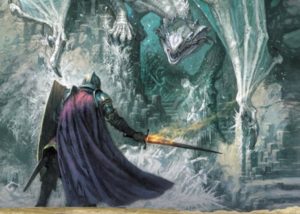 When the book moves into the core mechanics of the game, it’s standard D&D, though the Modular System continues to pop up with icons allowing you to tailor the game to your setting. From what I can see, it’s standard mechanics throughout, so having those icons can draw your eye to tell you where you have the option of changing them.
When the book moves into the core mechanics of the game, it’s standard D&D, though the Modular System continues to pop up with icons allowing you to tailor the game to your setting. From what I can see, it’s standard mechanics throughout, so having those icons can draw your eye to tell you where you have the option of changing them.
One of the large variant rules sections is Wounds, which is a Bloody Modular system. Characters HP represent scratches and bruises. Wounds are more devastating. You gain a wound each time you hit a quarter of your HP, or if a wound is 4+ higher than your CON modifier. When that happens, you roll on the location table, and take the condition listed. If you take a hit to the Torso you are winded (which is the same as the poisoned condition). A hit to the face blinds you for one minute. It’s a great way of dealing with more long-lasting effects without having to roll on a to-hit table every session. There’s also rules for Sudden Death if you so choose.
The Grimoire covers not only magic, but also detailing Living Magic, Awakening, Geomagic, and some of the variant rules from D&D’s DMG such as corruption and madness.
Living Magic introduces new ways magic can be used in the game. Critical magic is really cool, in that when a victim of magic critically fails a saving throw (rolls a 1), they take an additional hinderance, such as failing a Constitution saving throw will cause you to feel lightheaded, giving you the poisoned condition for 1d4 rounds. Each saving throw has a different effect. In the same way, critically succeeding on a saving throw against magic has a beneficial effect, such as a Strength saving throw giving you an extra attack the following turn, as well as doubling your speed to indicate it vitalizing you.
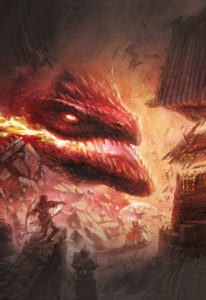 One thing we definitely need to talk about is the art. This RPG is absolutely GORGEOUS. The art throughout is absolutely incredible, the layout of the books are amazing, and the whole thing is SO evocative. I can tell exactly what kind of world this is just by flipping through the pages. The layout of everything is very nice. The books do, however, seem a little too spaced out. While it makes it easier to find the location of different things you’re looking up, it seems like some of it is simply padding to make the books larger and justify breaking the standard PHB D&D book up into two books. I don’t mind this, as it makes looking up spells and spell effects easier for spellcasters, but it’s something you may too notice.
One thing we definitely need to talk about is the art. This RPG is absolutely GORGEOUS. The art throughout is absolutely incredible, the layout of the books are amazing, and the whole thing is SO evocative. I can tell exactly what kind of world this is just by flipping through the pages. The layout of everything is very nice. The books do, however, seem a little too spaced out. While it makes it easier to find the location of different things you’re looking up, it seems like some of it is simply padding to make the books larger and justify breaking the standard PHB D&D book up into two books. I don’t mind this, as it makes looking up spells and spell effects easier for spellcasters, but it’s something you may too notice.
I really love Fateforge and this whole setting. It’s definitely a place I’d be happy taking my players to for future adventures, and even if you aren’t interested in the world, there’s a ton of really cool variant rules here you can use for any D&D campaign setting. With only a week left to go in the Kickstarter campaign, I highly recommend you get over there and back it.
Dice Monkey was provided a PDF copy of the Adventurers Core Book and Grimoire for review.

